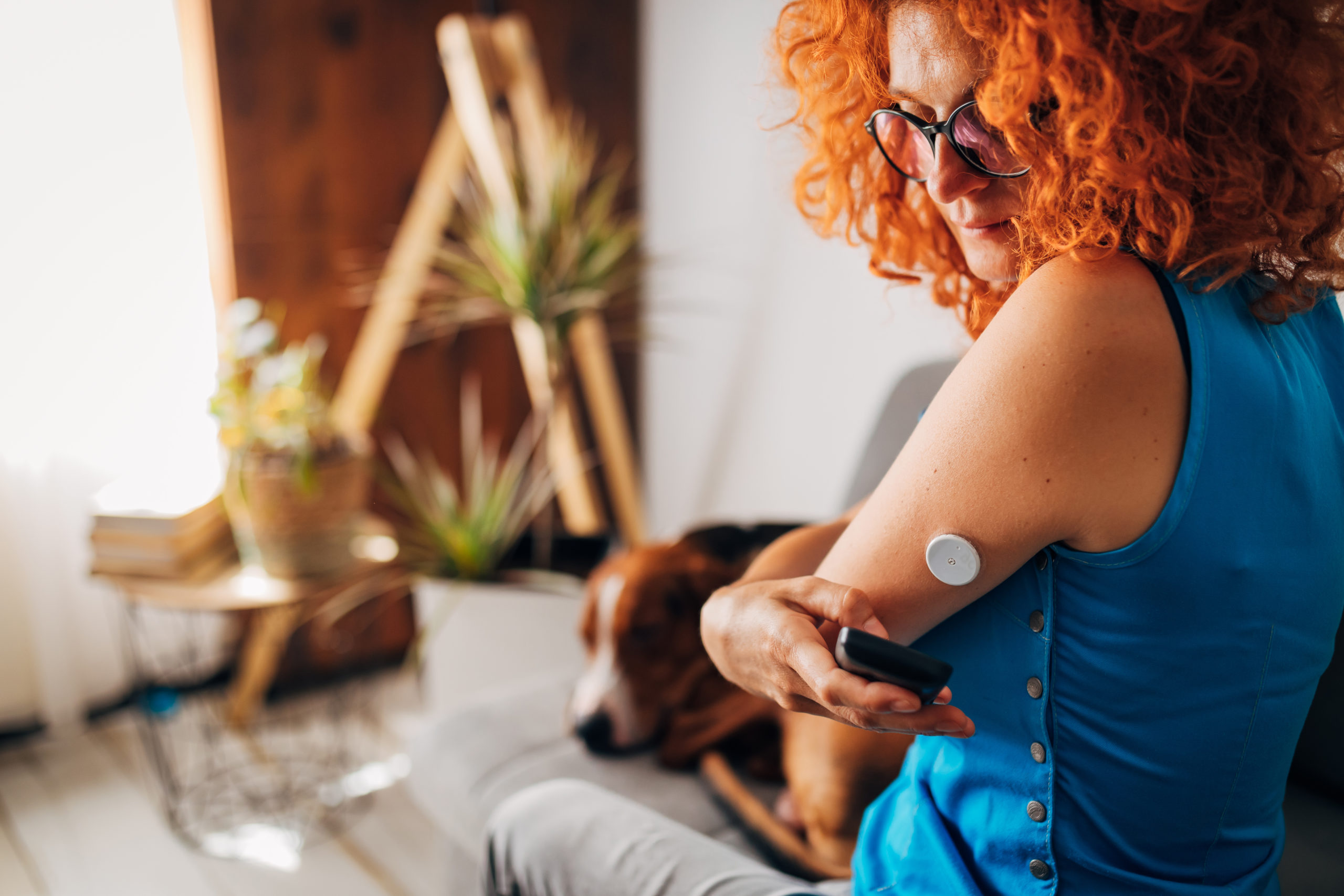When you think of blood sugar or diabetes management, you probably think of daily finger pricks and dripping blood onto a little test strip to monitor your glucose. Needles aren’t for everyone, nor is blood! But glucose monitoring isn’t only for people with diabetes—it can be a really handy tool for weight loss and improving your overall health.
Why Should You Monitor Your Blood Sugar?
It’s necessary for survival for us to have glucose in our blood—but only a certain amount (about a teaspoon, to be exact). Blood sugar rises when you eat, and the amount that it rises depends on how balanced your meal is. A high-carb meal will skyrocket your glucose, while a well-balanced meal that contains protein, fat, and fiber will increase glucose levels more steadily.
When blood sugar rises, your body secretes the hormone insulin to escort it into your cells for fuel and storage. Blood sugar moves fast, and insulin moves slow. So, if you are eating high-carb and high-sugar impact foods, or you’re a snacker constantly grazing throughout the day, both blood sugar and insulin can stay high.
Chronically high blood sugar causes a lot of problems in the body. When you have more insulin than your body knows what to do with, you can develop insulin resistance. This means that your cells aren’t getting the message and their doors are staying locked, keeping both blood sugar and insulin elevated.
If you're dealing with an increasing waistline, insulin resistance is likely a culprit. Insulin literally locks the doors on weight loss by triggering fat-storing enzymes and decreasing fat-burning enzymes—a knock-out punch for anyone trying to lose weight.
According to clinical nutritionist and women’s health expert Dr. Ritamarie Loscalzo, common symptoms of high blood sugar include:
- A fasting blood sugar level of 100-120 mg/dL (considered prediabetic)
- Fatigue, especially after a meal
- Craving for sweets, especially after a meal
- Brain fog
- Stubborn belly fat
Left unchecked, the chronic high blood sugar that leads to insulin resistance can pave the way for diabetes and heart disease.1 High blood sugar can damage your thyroid, throw your metabolism out of whack, and leave you on a roller coaster ride of cravings and crashing moods.
How to Manage Your Blood Sugar
If you’re already dealing with prediabetes or insulin resistance, the good news is that it can be reversed through diet and lifestyle. And the changes you need to make are foundational—you’ll find that improvements in one area will spill over into others and your overall health will improve.
- Balance your meals: You already know to get rid of the cookies, soda, and other high sugar-impact foods, but you might be wondering what’s left to eat. When building your meals, you want to eat by the plate. This means you want a good balance of lean protein, healthy fats, non-starchy vegetables, and high-fiber, slow low carbs. This allows glucose to enter the bloodstream at a steady rate, rather than spiking and causing wild swings in mood, energy, and more.
- Reduce your stress: Your adrenals regulate the stress hormones cortisol and adrenaline. When you’re stressed, your adrenals release more stress hormones, which causes your blood sugar to increase—so insulin increases as well. That’s how you gain belly fat. If you’re chronically stressed, your adrenals will eventually get fatigued. Then you’re tired all the time, which of course makes you go for more… sugar. And the cycle continues.
Learn how to manage stress in this episode.
- Get your sleep: When you're exhausted, it's even harder to balance your blood sugar and lose weight. You should be getting at least 7 to 9 hours of quality sleep a night. According to a 2010 study in the Journal of Clinical Endocrinology and Metabolism, just one night without enough sleep can trigger insulin resistance, which is linked to type 2 diabetes.2 It can also make you hungrier, and not for things like wild salmon and brussels sprouts!
Trouble falling or staying asleep? Hey, it happens to us all! Sleep Candy™ combines melatonin and other calming, sleep-supportive nutrients to help you get great sleep, every single night. You can only get it here.
- Move your body: The right exercise can provide the endorphin boost you tend to look for from the cookie jar, and it also helps quickly restore insulin sensitivity in the muscles. It's critical for long-term weight management because it helps burn up your fat-storing enzymes, and it boosts your metabolism so you burn more calories from fat throughout the day. One study in the Journal of Applied Physiology showed that the right exercises, like burst training, could improve blood sugar levels and reduce complications for people who already have diabetes.
- Measure your glucose levels: As I always say, what you measure, you can improve. I recommend investing in a continuous glucose monitor so you can keep track of your blood sugar throughout the day and see in real-time how food impacts your body.
What Is a Continuous Glucose Monitor (CGM)?
Glucose monitors are typically the finger-prick tests in which you place a drop of blood onto a test strip and insert it into a small device that will tell you your glucose level. This can be tedious to do multiple times a day (and painful!). A CGM stays on your body and provides way more data for you to take advantage of.
You can buy continuous glucose monitors online or at a drugstore. I use the Nutrisense CGM with an app and love the data it gives me.
How to Use a Continuous Glucose Monitor
With a CGM, there is a tiny sensor that goes under your skin, usually on your belly or arm. This sends your glucose reading to an app and it tracks your levels 24/7, so you can see how it changes over a few hours or days. This lets you spot trends and blips so you can figure out which foods don’t work for you.
I talk more about CGMs in this episode.
Seeing glucose levels in real-time can help you make better decisions about food, about your activity, and sometimes even your medications.
Of course, this is a life-altering tool for people with diabetes—they finally don’t have to stick their fingers all the time—but even if you don’t have diabetes, knowledge is power! A CGM can really help you troubleshoot before you have an issue with your blood sugar.
What to Look For:
If you’re monitoring your blood sugar throughout the day, you’ll want to see a reading of less than 100 mg/dL after fasting for at least eight hours, and less than 140 mg/dL two hours after eating.
Blood sugar levels may fluctuate after fasting for long periods of time, or an hour or two after you eat. But the fluctuations are minor, which means normal blood sugar levels stay within a really narrow range. For most people, this varies from about 82 mg/dL to 110 mg/dL and normal levels are around 90 mg/dL.
After a full meal, normal blood sugar levels may rise to nearly 140 mg/dl. But if blood sugar levels don't come back down several hours after you eat, that's a red flag for diabetes.
Knowledge Is Power
If you’re eating late at night, eating too many carbs, or you’re a snacker, you may not know how much you’re negatively impacting your blood sugar until you track it. Also, late night snackers tend to have higher fasting blood sugar in the morning, which you also wouldn’t know if you weren’t tracking.
When you monitor your glucose, your app can tell you whether your blood sugar is rising or dropping (and how fast), so you can choose the best way to get your sugar back to normal. Some CGMs even have alarm settings that alert you if your blood sugar becomes too low or high—and you can have other people or your doctor notified, too.
Once you have your blood sugar stabilized and working well, you’ll be able to use stored fuel to keep your weight under control and diabetes away. You’ll also have good, steady energy, your workouts will improve, and you’ll be able to sleep better because you won’t be fighting hypoglycemic crashes. Read more about why snacking can mess with your glucose levels and stop fat loss here.
High sugar impact foods can mess with your blood sugar and stall fat loss. But everyone deserves an occasional treat! We’ve got recipes for brownies, cookie bites, freezer fudge + more in my Sweet Treats Guide—big flavor with low sugar impact. It’s FREE, so download yours here.
The views in this blog by JJ Virgin should never be used as a substitute for professional medical advice. Please work with a healthcare practitioner concerning any medical problem or concern. The information here is not intended to diagnose, treat, or prevent any disease or condition. Statements contained here have not been evaluated by the Food and Drug Administration.
References
- Abdul-Ghani MA, Jayyousi A, DeFronzo RA, Asaad N, Al-Suwaidi J. Insulin Resistance the Link between T2DM and CVD: Basic Mechanisms and Clinical Implications. Curr Vasc Pharmacol. 2019;17(2):153-163. doi: 10.2174/1570161115666171010115119. PMID: 29032755.
- E. Donga, M. van Dijk, J. G. van Dijk, N. R. Biermasz, G. J. Lammers, K. W. van Kralingen, E. P. M. Corssmit, J. A. Romijn. A Single Night of Partial Sleep Deprivation Induces Insulin Resistance in Multiple Metabolic Pathways in Healthy Subjects. Journal of Clinical Endocrinology & Metabolism, 2010; DOI: 10.1210/jc.2009-2430
- 3. J.P. Little et al., “Low-Volume High-Intensity Interval Training Reduces Hyperglycemia and Increases Muscle Mitochondrial Capacity in Patients with Type 2 Diabetes.” Journal of Applied Physiology (1985) 111, no. 6 (2011): 1554-60.






